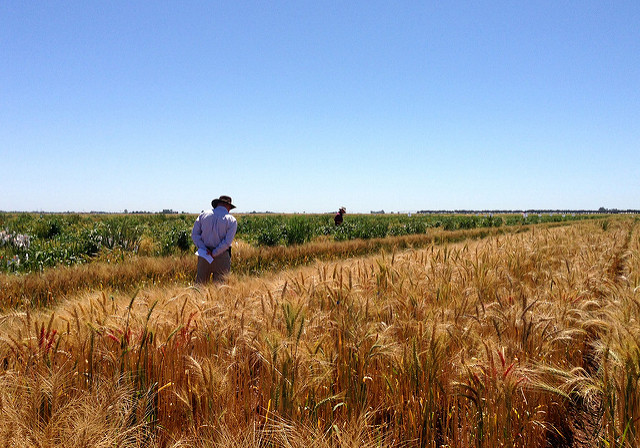
CIUDAD OBREGON, Mexico (CIMMYT) — Mexico aims to boost domestic wheat production 9 percent to 3.6 million metric tons by 2018, said a government official speaking on Tuesday at a conference in the town of Ciudad Obregon in the northern Mexican state of Sonora.
Productivity will increase as a result of growing investment in infrastructure, machinery, equipment and technological innovations, said Sergio Ibarra, Sonora delegate of the country’s Secretariat of Agriculture, Livestock, Rural Development, Fisheries and Food (SAGARPA).
“The strategic vision of the Mexican government is to promote an agricultural landscape that supports a productive, competitive, profitable, sustainable and fair agri-food sector to ensure food security,” Ibarra said, addressing 75 international scientists and wheat breeders attending the International Wheat Yield Potential Workshop hosted by CIMMYT.
The Mexican government has a long and storied tradition of working alongside CIMMYT, which developed improved varieties of wheat under the leadership of the late Nobel Peace Prize winner Dr. Norman Borlaug, helping the country become self-sufficient in grain production in the 1960s. Currently, demand for wheat in Mexico outstrips the domestic supply produced.
One collaborative project, the Sustainable Modernization of Traditional Agriculture, led by SAGARPA and known locally as MasAgro, helps farmers understand how minimal soil disturbance, permanent soil cover and crop rotation can simultaneously boost yields and sustainably increase profits.
ENVIRONMENTAL PRESSURES
Delegates at the Wheat Yield Potential Workshop, held from 24 to 26 March, plotted out how current and potential global research projects could dovetail under the International Wheat Yield Partnership (IWYP), a public-private partnership focused on developing new high-yielding varieties of wheat.
Findings in a report released last year by the Intergovernmental Panel on Climate Change (IPCC) state it is very likely that heat waves will occur more often and last longer throughout the 21st century and rainfall will be more unpredictable. Mean surface temperatures could rise by between 2 to 5 degrees Celsius or more, the report said. Current crop models show scenarios of the impact of rising temperatures on wheat varieties, which provide 20 percent of calories and protein consumed worldwide.
“Models indicate that a 2 degree increase in temperature would lead to a 20 percent reduction in wheat yield; a 6 degree increase would lead to a 60 percent reduction,” said Hans Braun, head of CIMMYT’s Global Wheat Program and the Consultative Group for International Agricultural Research Research Program on Wheat. “The consequences would be dramatic if we had a 40 percent yield reduction because we already know wheat production has to increase by 60 percent to keep up with population projections,” Braun said. “If we add modeled climate risks, the challenge is compounded, and we’ll need to double the yield capacity of our current varieties.”
“CIMMYT has demonstrated that the rate of improvement in yield gain has slowed to the point that, if it carries on the present rate, we’ll have a large gap between the amount of available wheat and what we need to feed the population,” said Steve Visscher, international deputy chief executive at Britain’s Biotechnology and Biological Sciences Research Council (BBSRC). The Council is the largest financial contributor to IWYP, which has so far secured 50 percent of the $100 million in funding it seeks to develop higher yielding wheat varieties.
“The sooner we act, the greater the chances are that we can close the gap between forecast demand and the availability of wheat,” Visscher said. “The scale of that challenge means that we need an international community effort, and the work on wheat yield that CIMMYT has initiated has now been taken forward through IWYP. I pay tribute to the role of SAGARPA and the Mexican government for backing CIMMYT and providing funding in recent years.”
Rothamsted Research in the UK is trying to meet the wheat food security challenge through a program to increase the yield of wheat to 20 metric tons per hectare within the next 20 years.
“Given that the UK record yield is currently 14.3 tons, that’s a big, big target,” said associate director Martin Parry, whose work aims to boost wheat photosynthesis, leading to increased yields.
“There are big risks both in terms of food security and political stability– it’s critical that the world’s population has enough food to eat– we need to work in a collegial, collaborative way, and IWYP offers an ideal opportunity to do that,” Parry said.
 Nutrition, health and food security
Nutrition, health and food security